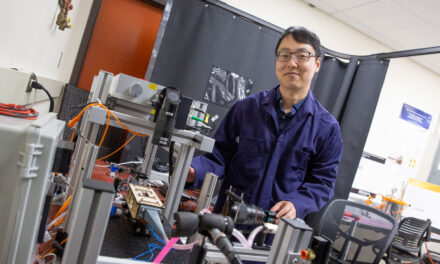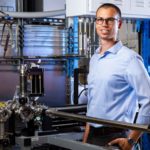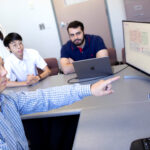
Four Ira A. Fulton School of Engineering faculty members are among 19 winners of the inaugural ASU Faculty Achievement Award for outstanding intellectual achievement
April 13, 2007
•James Adams, a professor in the School of Materials (which is jointly administered by the engineer school and the College of Liberal Arts and Sciences), for “Instructional Pedagogy”
•Ronald Adrian, a professor in the Department of Mechanical and Aerospace Engineering, for “Best Professional Application”
•Michael Kozicki, a professor in the Department of Electrical Engineering, for “Most Significant Invention”
•Joseph Wang, a professor in the Department of Chemical Engineering, for “Defining Edge Research in Natural Science and Math”
The winners will be honored from 3 to 5 p.m. April 24 at an awards event at the ASU Art Museum.
Adams has consistently been among the highest-ranked teachers in the materials science and engineering program for the past decade.
He has made major innovations in teaching introductory materials courses. He developed Materials Quicknotes, a four-page laminated study guide providing key concepts and equations for the entire course in a compact form. The guide is published by ASM, the leading national materials society, and 10,000 copies have been purchased by students at more than 30 universities.
He also has developed Materials Concepts, a detailed 200-page lecture/study guide that is used by a number of ASU instructors. Students consistently rate the guide as one of the most effective educational aids.
Adams developed two new courses, Computational Modeling of Materials and Computational Quantum Mechanics, which have bee highly rated by students. He also created a new Materials Science and Engineering 100 course, using hands-on, team-based activities that turned a course that had been among the most unpopular among students into one of the most popular.
Adrian is being recognized for contributions to developing experimental diagnostics. He’s among pioneers in development of the laser Doppler velocimeter (LDV) technique for the measurement of point-wise velocities in fluid flows.
His contributions to LDV include three patents and an edited collection of research paper on LDV for the Milestone Series of the Society of Photo-Optical Instrumentation Engineers.
He is one of the founders of the field of particle image velocimetry (PIV), a widely used method for measuring instantaneous vector fields in two and three dimensions.
Adrian was noted by Thomson Scientific as being among the 250 most cited researchers in published articles between 1981 and 1999.
Kozicki is being recognized for his invention of the Programmable Metallization Cell, a novel method and devise for implementing computer memories. He has 39 patents issued on the technology, which address critical needs of computer memory manufacturers worldwide.
In addition to the patents, Kozicki’s work has led to three major technology licensing agreements that are providing substantial licensing income and research funding for ASU.
Wang has become a recognized leader in electrochemistry. He has written more than 700 papers in the field published by major international journals, becoming one of the most highly cited authors in engineering.
Wang also developed the popular technique of adsorptive-stripping voltammetry and introduced the concept of permselective surface coatings, as well as the powerful analytic tool of potentiometric stripping analysis.
He has been a pioneer in electrical detection of DNA and other biosensor methods and technologies, a field in which he continues to be considered one of the leading innovators.



































